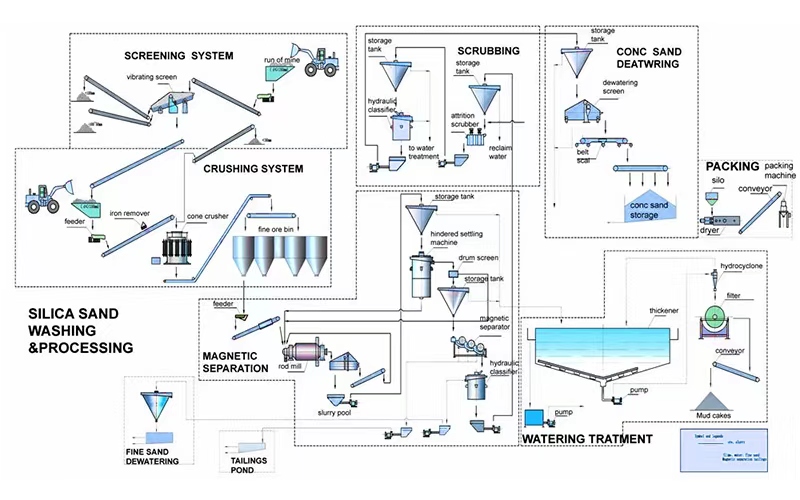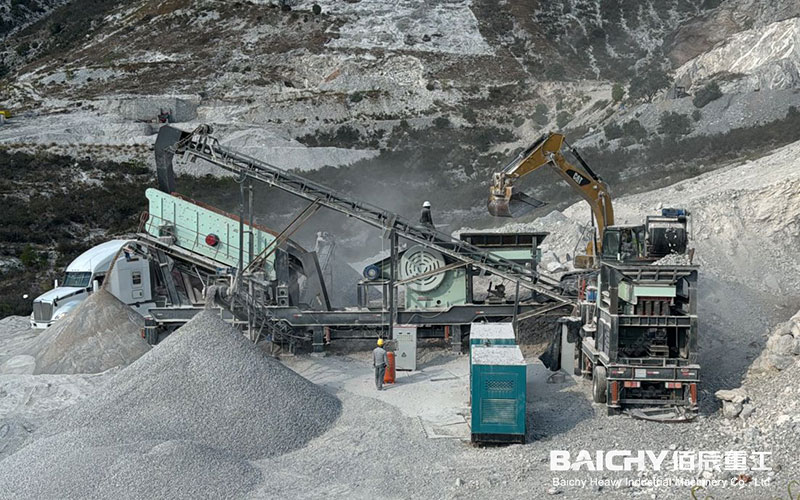
Choosing the right size dewatering screen for a sand and gravel processing plant is crucial for ensuring efficient and stable production line operation and product quality. Oversized screens waste investment and energy; undersized screens result in insufficient processing capacity, poor dewatering, and become a bottleneck in the entire production process. The following is a selection guide based on core dimensions.
I. Core Determinants: Define Your Production Needs
Selecting the size of a dewatering screen cannot be based on intuition; it must be based on the following three quantifiable indicators:
1. Hourly Processing Capacity (tons/hour)
◦ This is the primary basis for selection. You need to determine the maximum hourly flow rate of material entering the dewatering screen in your production line. For example, do you need to process 50 tons, 100 tons, or 300 tons of material per hour?
◦ Recommendation: Add a 10%-20% margin to the calculated maximum flow rate to accommodate raw material fluctuations or future production increases.
2. Material Characteristics
◦ Particle Size Distribution: The ratio of coarse to fine particles in the material is critical. If the fine sand (e.g., 0-3mm) content is high, dewatering is more difficult, requiring a larger dewatering area or longer time. If it's a sand-gravel mixture (e.g., 0-5mm or 0-10mm), dewatering is relatively easier.
◦ Mud Content: Materials with high mud (extremely fine particles) content not only easily clog the screen but also increase the viscosity of water, making it difficult to separate water from the particles, requiring a larger dewatering area or a lower throughput.
◦ Feed Concentration: The concentration of the slurry entering the dewatering screen directly affects the dewatering efficiency. The higher the concentration, the less water needs to be removed per unit time, allowing for the selection of a smaller equipment.
3. Dewatering Target (Finished Material Moisture Content)
◦ What are your requirements for the dryness/wetness of the finished material?
◦ Ordinary construction sand: Generally, a moisture content of less than 15% is required for easy transportation and mixing.
◦ High-standard manufactured sand or dry powder mortar raw materials: A moisture content of less than 10% or even lower may be required.
• Tailings dry stacking: Requires extremely low moisture content, achieving the effect of "clumping together when squeezed but crumbling when released." This typically requires higher-strength dewatering screens or multiple units working together.
• More stringent requirements mean a longer dewatering path (i.e., larger screen size) or a slower screening speed.
II. Key Parameters for Dewatering Screen Dimensions
The "size" of a dewatering screen is usually expressed by its screen width and length, for example, 2m * 6m.
• Screen width: Primarily determines processing capacity. A larger width allows for a greater amount of material to be processed per unit time. It is a key parameter for addressing "quantity."
• Screen length: Primarily determines dewatering effect. A longer length allows for a longer residence time (dewatering time) of the material on the screen, resulting in more thorough dewatering and a lower moisture content in the finished product. It is a key parameter for addressing "quality."
Selection Principle: Under the premise of meeting the processing capacity (width), select an appropriate screen length based on your requirements for the finished product's moisture content.
III. Practical Selection Steps and Comparison Table
Step 1: Data Collection
Collect all data mentioned in Step 1 above: maximum throughput, material particle size analysis, mud content estimation, feed concentration, and target moisture content.
Step 2: Preliminary Width Determination
Based on the throughput, refer to the parameter table provided by the equipment manufacturer for preliminary matching. Below is a simplified reference table (using common sand and gravel materials as an example, with a feed concentration of approximately 50%-60%):
| Estimated Processing Capacity (tons/hour) | Recommended Common Dewatering Screen Widths | Examples of Corresponding Common Models |
| 30 - 50 t/h | 1.2m - 1.5m | TSS1245, TSS1548 |
| 50 - 100 t/h | 1.8m - 2.4m | TSS1848, TSS2460 |
| 100 - 200 t/h | 3.0m | TSS3060 |
| Above 200 t/h | 3.6m or Multiple units in parallel | TSS3660 |
Note: This table is for rough reference only. If the material is fine, contains a lot of mud, or requires a low moisture content, a larger size should be selected.
Step 3: Determine the Length and Model
After determining the width, communicate your dewatering goals in detail with the equipment supplier.
• Standard Dewatering (Moisture Content ~15%): Choose a model with a standard aspect ratio, such as the 1848 (1.8m wide, 4.8m long).
• Deep Dewatering/Dry Discharge (Moisture Content <10%): Choose a model with a larger aspect ratio, i.e., a "slender" screen, such as the 1860 (1.8m wide, 6.0m long), to extend the dewatering time.
IV. Other Important Selection Considerations
• Equipment Quality and Vibration Force: Large-size dewatering screens require more powerful vibrating motors to provide sufficient vibration force for effective material conveying and compaction. Ensure the equipment structure is robust enough to withstand long-term high-intensity vibration.
• Screen Material: For highly abrasive sand and gravel materials, choose screens made of highly wear-resistant materials (such as polyurethane screen panels) to extend service life and reduce downtime for replacement.
• Seek Expert Advice: The most reliable approach is to provide your material samples to experienced equipment manufacturers. They can conduct experimental analysis and provide the most accurate selection plan and quotation.
Choosing the right dewatering screen size for a sand and gravel plant is a systematic process of weighing options. The core principle is to base adjustments on the processing capacity, material characteristics, and dewatering targets. Do not choose an undersized device simply because of price; otherwise, subsequent capacity bottlenecks and maintenance costs will far outweigh the initial investment savings. The best approach is to rely on data, professional consultation, and on-site inspections.
Hopefully, this detailed guide will help you make the wisest choice!











